All the People Become Mirrors
A conversation on contemporary farewell practices with Barbara Raes
Our lives drift apart: on this slippery neoliberal surface, as smooth as an operating table where profit is extracted from our bodies, our affective lives struggle to gain traction.
The following is a conversation that took place in the summer of 2024 via a video call that lasted an entire afternoon, followed by an intense email exchange. At that time, I was at my parents’ home in a small town in the province of Salerno in Southern Italy, next to my father, who had recently undergone surgery. Something had been lost: the right upper lobe of his respiratory system. This recalled the absence of rituals for dealing with life transitions: welcoming a new state of frailty.
This is a conversation about the practice of Barbara Raes, a Belgian artist, and curator, who occupies a unique position to explore the contemporary imagery of art as a matter of care in relation to loss and mourning.
As guest curator of Theatre by the Sea #2018 in Ostend, Belgium, Barbara developed one of her most representative pieces, Zon dag kind (Golden Child), a ritual for children who have experienced a major loss. Zon dag kind is a journey that begins with the child, unaware of what awaits him, being invited to spend the night aboard a fishing boat that sets sail before dawn. Far from the mainland, they are awakened by a Sun Princess who asks for their help in raising the sun by singing a song. Zon dag kind was designed for an audience of one—the participating child—while others could only observe and wave from a distance as the boat returned at sunrise.
In addition to her work in public rituals and curatorship, Barbara established her private practice, Beyond The Spoken. This workshop, dedicated to unrecognized forms of loss, offers farewell rituals co-created with artists to mark both significant and minor life transitions—such as job loss, surgery, or divorce.
Antonio Ianniello: I’d like to begin by reflecting on a pivotal moment in your life, one that marked a significant shift in your career. After dedicating many years as a dance curator and artistic director for institutions such as Vooruit in Ghent and the BUDA Arts Center in Kortrijk, you made the decision to step away in 2014. You’ve spoken openly about how a severe burnout played a central role in this decision. Could you share more about how you navigated this difficult period, and how this transformative journey has influenced the direction of your current work, particularly in relation to your exploration of grief, loss, and the creation of new rituals?
Barbara Raes: I decided to take a one-year sabbatical, not to do nothing, but to create space for doing nothing. I had an office to go to where I could do nothing—just giving water to the plants, sometimes cooking, and trying to read. But it wasn’t very efficient. My basic question was: what can I do? The world is changing so fast, and I am changing too. How can I make this year meaningful?
Let’s do something in a field that I don’t know anything about. That’s when I chose to go to Totnes, in the UK, to an alternative funeral business center where they were teaching people to become funeral directors and to direct funeral ceremonies. I spent half a year there in education.
This period was very important for two specific moments. One was on the first day when we were there, and we had to observe the process in the crematorium, witnessing the burning of the body. In the crematorium, there was a small window through which we could see the coffin being placed in. We were required to observe the entire process, from the beginning to the end, watching the dead body burn. I was completely unprepared for what I encountered. The course, titled Facing Your Own Death, was something I had joined almost by coincidence, and I hadn’t anticipated having to confront this. So I asked the funeral director “Why do we have to see this? Why is it so important to witness the entire process?” I remember him saying, “If you want to support and work with people in grief—people who have lost someone—it’s crucial to be authentic. You need to be able to answer any question they might have honestly, and the only way to do that is by having seen it yourself. They could ask you, “How do I know these are really my father’s ashes and not someone else’s?” They’ll believe you if you can answer based on what you’ve actually seen.” I could completely understand this argument. So I said, “Okay, I need to see it again tomorrow because I was too shocked the first time.” I needed to truly embody the experience—to feel it, to see it, even to hear the sound of the coffin being placed into the flames—to be able to support and contain the grief of those losing someone. That was profoundly important for me.
The second crucial moment came a bit later. As part of the course, we had to spend a full day working on our personal relationship with religion, spirituality, vision, and philosophy. At the time, I had either just come out of burnout or was still in it—I don’t quite remember. But, of course, when you’re in that phase of your life, you’ve lost all belief in anything. You feel so alienated from the values of others that you start wondering, “Why should I continue like this?” You begin to lose track of how you relate to religion, spirituality, and philosophy. We had to dedicate an entire day to this, and the reason for it—something that later became essential to my practice—was what he explained to us: “You need to know this very well for yourself, but also be able to keep it to yourself. When working with people in grief, we are so used to projecting our own experiences—our own grief, traumas, and even our personal relationship with religion or spirituality—onto others. We do this because it has helped us in some way, but in doing so, we fail to create space for them.” That day was about learning to hold our own beliefs while allowing space for others to bring theirs into the process.
Antonio Ianniello: Looking back on your time in Totnes, how did this apprenticeship evolve both personally and professionally, and what moments or realizations during this process led you to understand its deeper meaning? I’m particularly curious about the turning points that helped you make sense of your time there. How did the seemingly coincidental choice to explore funeral rites and the contemplation of grief and loss gradually come together to inform the development of your approach to ritual creation, ultimately leading you to launch Beyond The Spoken?
Barbara Raes: I didn’t know why I was there, why I was taking this course, or what I wanted to do with it—until we had our final exam. The assignment was to create a farewell ritual for a fictional scenario, and it turned out to be a profound turning point for me.
The scenario was this: two men are in a relationship. One of them is terminally ill, and the other wants to marry him before he dies. However, at that time, gay marriage is not legal in the UK, so it isn’t possible. A year later, the dying man has passed away, and gay marriage has since become legal. The task was to create a farewell ritual that both commemorates the deceased and symbolically marries him to his surviving partner—while also acknowledging the presence of the surviving partner’s new significant other.
This exercise was an eye-opener for me. It made me realize that we don’t just need alternatives to traditional rituals; we need entirely new rituals for new situations in our society because society is changing so fast, the way we live together, our family constellations, like all this kind of traditional square ways to think or see patterns in society are becoming more fluid.
That’s when I decided to start Beyond the Spoken. I wanted to explore the kinds of loss we often fail to formally acknowledge, the ones society doesn’t recognize as legitimate but that still require tools and rituals to navigate through these transitional phases.
Antonio Ianniello: After completing your apprenticeship and engaging deeply with the philosophical and practical aspects of funeral rites, how did you begin to translate this knowledge into tangible practice? Could you walk us through the steps you took to move from your experience in Totnes to creating real-world rituals? What specific challenges did you face in adapting and expanding upon traditional rituals, and how did you develop an approach that not only honors personal loss but also addresses the broader, often unacknowledged, transitions in people’s lives? I’m also interested in how your previous experiences as a curator and artistic director influenced the way you approached ritual creation, particularly in the context of creating rituals for losses that society often overlooks.
Barbara Raes: I had a year of preparation, testing whether I could apply everything I learned at Green Fuse to traditional farewell rituals and transcend them to other situations. I created rituals, but only privately for friends and family. For example, one of my close friends had a double mastectomy because of cancer, so I created a ritual for her. Then, another friend was going through a divorce, so I created a ritual for that. What I realized was that I needed the imagination of arts to help me create rituals to transcend beyond mere spirituality. That’s when I saw that this approach could actually be very valuable in society. So I decided to open it up and make Beyond the Spoken public. By that point, I had already started working on it, and since then, I’ve been creating rituals for unacknowledged losses. At the time, I was addressing things like surgery and divorce—what might seem like “simpler” losses. But over time, the people coming to my practice have brought much more complex questions and experiences in need of rituals.
The van Ganneppian structure of rites of passage has been and continues to be a guiding principle in my approach to ritual creation. Beyond the three fundamental stages—separation, transition, and reintegration—I incorporate a dramaturgical flow, which I visualize as an S-curve. This structure emerged from my study of funeral rituals, particularly at Green Fuse, where I was required to attend funerals of people I had never met. Over that period, I observed approximately 80 funerals, analyzing their structure to understand the dramaturgy—if I may use an artistic term—of a good, good, valuable, meaningful goodbye.
This curve describes an energetic process that begins with low energy during the separation phase, where mourners need to be grounded. As the facilitator, it is my role to raise their energy to a higher level before they can address their sadness and say their goodbyes. You have to talk about life. You have to ensure that everyone can visualize the person we’re saying goodbye to, recalling them with joy, sharing memories, and talking about them in terms of colors, smells, and other sensory details. Then, once the energy has risen, you must allow it to drop again, because it’s time to acknowledge that, indeed, we have to say goodbye to this person. It’s important that we all acknowledge that the person doesn’t live anymore and we say goodbye. And so the energy drops to a point lower than where it began. This is, of course, the most fragile moment in the ritual, where the deepest grief surfaces and the possibility for tears is greatest. This moment is also highly ephemeral—a liminal space, a point of transition. From here, at the lowest point, you slowly begin to lift the energy again, speaking of comfort, love, and everything that brings consolation to the family, ultimately ending on a higher note than where you began. The therapeutic effect of the ritual emerges in this reintegration phase. If you visualize it as a line, everything above the starting point represents this healing effect. I incorporate elements into this process: beginning with earth, moving through fire, then air—associated with liminality—before arriving at water, which offers the most comfort. The design of the ritual, holding the space, allows for this S-flow to unfold.
Antonio Ianniello: To wrap up our conversation, I’d love for you to share some insights into the preparatory work behind the ritual. How do you begin to help participants connect with the collective nature of the experience? How do you navigate the sensitive dialogue with the bereaved, ensuring their personal mourning is both respected and transformed into a collective expression? Furthermore, how do you foster a sense of community in these moments, where individuals come together to articulate and embody the shared ritual? In your experience, what role does collectivity play in facilitating a meaningful transition from private sorrow to communal healing?
Barbara Raes: There are many levels in the preparation process. First, I have a lot of one-on-one conversations with the person for whom I’m doing the ritual. I need to understand what they’ve gone through, what happened, and what trauma they are seeking to heal through this ritual. This preparation can take anywhere from one week to two years. A second layer is the connection with other people. During these one-on-one conversations, I always reach a point where I need to ask: “Who do you want to be there for your ritual?” This question often surprises people. They expect the ritual to be something private, just between us. But no, my question is: “Who do you want to be there?” There are two reasons for this. First, they need people there for support. You need people who are important to you, who understand the grief you’re going through, and can be there for you. Second, the people who witness the ritual will become mirrors in the future. Their presence helps you remember the experience, reinforcing the changes the ritual brings. Before we start the ritual with the group, I invite them two hours ahead of time to explain what we’ll be doing, and to assign them specific roles within the ritual. But before the person arrives for whom we’re performing the ritual, I always tell everyone two things: “No photos, and it’s not about you.” This is important because when people get caught up in the energetic flow of the ritual, it’s natural for them to project their own feelings and issues onto the process. When this happens, it’s crucial that I can remind them, “It’s not about you,” so that they can contain their own energy and allow me to hold the space for the ritual. It ensures that the focus remains on the person for whom the ritual is being performed, and the energy doesn’t shift onto their own personal issues. Even though the ritual isn’t about them, I know that it affects them, too. Afterward, it may take some time for them to re-enter the world. But I know that by being there, by supporting the person, and by carrying the ritual together, something has shifted within them.
We need each other. This shift away from the neoliberal idea that we are alone in the world, and that if we just do our best we will be successful, is changing. We didn’t bring ourselves into the world, and we won’t bury ourselves.




